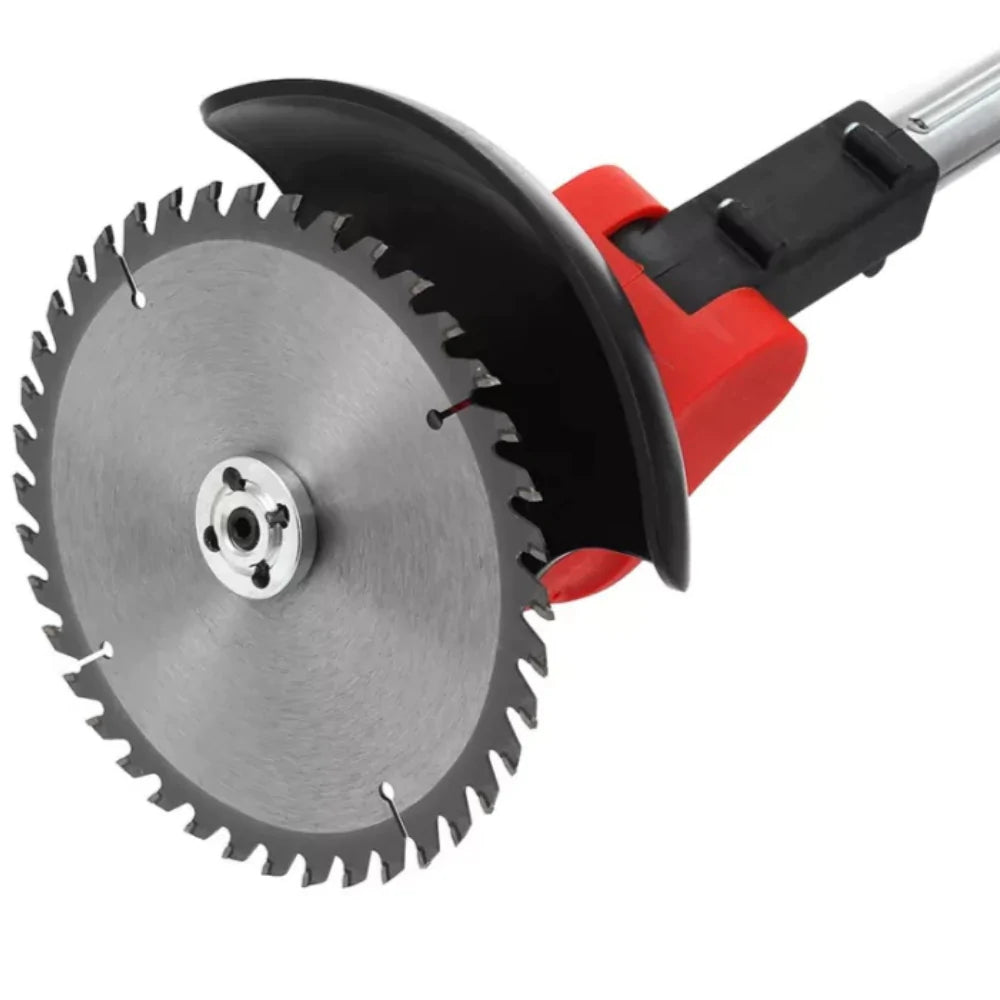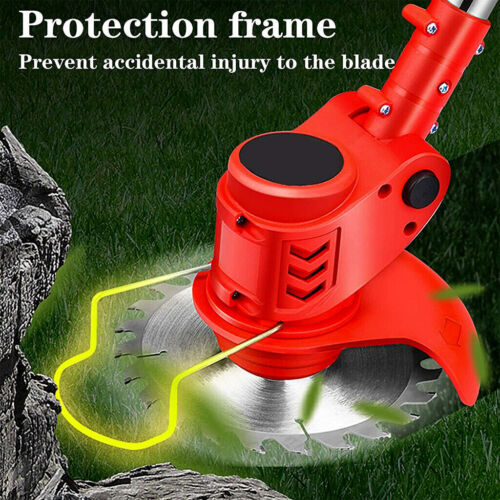Brush cutters are versatile tools designed for various vegetation-clearing tasks. One critical aspect of their functionality is the choice of the blade. There are four primary types of brush cutter blades available: Knife, Chisel, Smasher, and Mulching. In this article, we'll delve into the characteristics, pros, and cons of each blade type to help you make an informed choice.

Knife Blades:
Knife blades are the most common type of brush cutter blades. They feature a sharpened knife edge on the front, cutting through vegetation by slicing. These blades are often made from thin sheets of steel, and their shapes can vary from rectangular to round, with numerous small knife-like teeth. The most common design is the star shape, featuring three or four cutting edges.
Pros:
- Cost-effective due to their simple construction.
- Effective at cutting soft materials like grass and watery weeds.
- Can handle considerable punishment depending on their design and steel quality.
Cons:
- Efficiency declines rapidly as the knife edge dulls because only the blade's tip performs cutting.
- Vulnerable to damage when encountering rocks or hard objects due to their fixed nature.
- Blades with many teeth can wrap long grasses around the gear head.
Chisel Blades:
Chisel blades feature sharpened teeth around their perimeter and cut through vegetation by chiseling or shaving. They are circular and come in various tooth configurations, such as chain saw-type blades.
Pros:
- Efficient at cutting, especially through woody weeds and hard woods.
- Suitable for cutting larger branches (up to 50-60mm in diameter) but may slow down as cutting depth increases.
Cons:
- Generally more expensive due to their complex shape.
- Teeth require sharpening and can be challenging to maintain.
- Prone to kicking if not used carefully, which can lead to dangerous situations.
Smasher Blades:
Smasher blades have no sharp edges and rely on their weight and thinness to smash through vegetation. These blades often pivot, and there are various designs, including linked metal blades and chains.
Pros:
- Maintain efficiency without requiring edge maintenance.
- Effective for cutting soft grasses and watery weeds.
Cons:
- Generally more expensive due to multiple parts.
- Limited effectiveness against woodier weeds and can wear out quickly.
- High drag for some designs, requiring more powerful machines.
Mulching Blades:
Mulching blades are designed for mulching vegetation. They come in various configurations and are especially effective when moving the blade vertically through the vegetation.
In Summary:
- Knife blades are cost-effective but lose efficiency quickly and can be prone to damage.
- Chisel blades are efficient cutters but require careful handling.
- Smasher blades are effective for soft materials but struggle with denser vegetation.
- Mulching blades excel at mulching and can be versatile depending on the design.
Ultimately, the choice of a brush cutter blade should align with the type of vegetation you intend to clear. Some brush cutters come with a range of blades to handle different situations. Understanding the characteristics and limitations of each blade type can help you make the right choice for your specific needs.

Mulching blades are specially designed to break down vegetation into small pieces, making them ideal for creating mulch. When used by moving the blade vertically through the vegetation, these blades shine.
Types of Teeth:
There are three primary types of teeth found on chisel blades:
- Steel Teeth: These blades were once common but are less so now. Some cheaper blades lack tooth offsets, making them prone to binding in wet sap timber. Blades with good offsets and teeth resembling chainsaw blades that can be sharpened with a chainsaw file are recommended.
- Chain Saw Teeth: Some chisel blades incorporate actual chainsaw blades riveted between two steel discs or chain saw teeth segments riveted directly to a single steel disc. These teeth must be kept sharp for effective cutting but can be sharpened with a chainsaw file with practice.
- Tungsten Carbide Teeth: Blades with tungsten carbide tips welded to the steel teeth offer exceptional hardness and durability. However, they can still chip when subjected to high-speed impacts, making them more suitable for brush cutters than low-speed chainsaws.
Number of Teeth:
While many believe that more teeth are better, the reality is different when it comes to efficiency and power. Fewer teeth can be more effective, especially when cutting larger saplings. Fewer teeth mean more power is applied to each tooth, resulting in more efficient cutting. However, chipped teeth can impact performance, so maintenance remains crucial.
Smasher Blades (Continued):
Smasher blades are unique because they lack sharp edges and rely on thinness and weight to break through vegetation. Common types include pivoting flail blades, linked metal blades, and chain designs.
Pros:
- Smasher blades maintain their efficiency without needing edge maintenance.
- They work well with soft grasses and watery weeds.
Cons:
- These blades are generally more expensive due to their multiple parts.
- They may not withstand extreme loads and can have a short lifespan.
- Smasher blades are primarily suited for grass and water weeds, not woodier vegetation.
BrushDestructor: The 4-in-1 Blade:
The BrushDestructor blade stands out as a versatile option. It can function as a smasher, knife, chisel, and mulching blade, depending on how you sharpen the flail blades. While it comes with some advantages, it also has its drawbacks.
Pros:
- Replaces the need for various other nylon line and metal blades.
- Designed to offer a long lifespan.
- Runs smoother due to the shock-absorbing nature of flail blades.
- Provides a short-term flywheel power reserve thanks to its heavy hubs.
- Generates less kickback compared to fixed blades.
- Easy to keep teeth sharp.
- Offers more functionality with less power consumption.
Cons:
- Considerably more expensive than traditional blades.
- Requires regular inspection, and pivot bolts should be sprayed with oil after each use.
- Regular sharpening is necessary to maintain peak performance.
In conclusion, the choice of a brush cutter blade should align with your specific vegetation-clearing needs. Understanding the characteristics, advantages, and limitations of each blade type will enable you to make an informed decision and maximize the efficiency of your brush cutter for various tasks.

Choosing the Right Blade for Your Brush Cutter:
Selecting the appropriate blade for your brush cutter is crucial to achieving optimal results. Here are some guidelines to help you make the right choice:
- Assess Your Clearing Needs: Consider the types of vegetation you'll be tackling. If you're dealing with predominantly soft grasses and watery weeds, knife blades or smasher blades may suffice. However, if you're working with tougher, woody vegetation, chisel blades or mulching blades might be more suitable.
- Evaluate Your Equipment: Ensure that your brush cutter has the power and torque to handle the selected blade type. Some blades, especially chisel blades, may require higher-powered machines to operate effectively.
- Maintenance Considerations: Think about your willingness and ability to maintain the blade. Knife blades and smasher blades tend to require less maintenance compared to chisel blades, which need regular sharpening. Mulching blades may also require occasional maintenance to ensure consistent performance.
- Budget: Take your budget into account. While some blades may be more expensive upfront, they could save you money in the long run if they are more durable and efficient for your specific needs.
- Safety Precautions: Be aware of the potential risks associated with each blade type. Chisel blades, in particular, require careful handling to prevent kickbacks, while smasher blades may have limited effectiveness against harder vegetation.
- Consider Versatility: If you have a variety of clearing tasks, a versatile blade like the BrushDestructor 4-in-1 blade might be a wise investment. It can adapt to different cutting needs with a single blade.
- Review User Feedback: Check for reviews and recommendations from other brush cutter users who have faced similar challenges. Their experiences can provide valuable insights into which blade types work best in specific situations.
- Consult with Experts: If you're unsure about the best blade for your needs, consult with experts or professionals in the field of vegetation management. They can offer personalized advice based on their experience.
Safety Reminders:
Before we conclude, it's essential to emphasize safety when using a brush cutter, regardless of the blade type you choose. Here are some safety reminders to keep in mind:
- Wear Protective Gear: Always wear appropriate personal protective equipment (PPE), including safety glasses or a face shield, hearing protection, a helmet, gloves, and steel-toed boots. Additionally, consider wearing a full-body protective suit when operating in dense or thorny vegetation.
- Inspect Your Equipment: Before each use, inspect your brush cutter for any damage or wear, paying particular attention to the blade and its mounting hardware. Ensure that all components are in good working condition.
- Follow Manufacturer's Guidelines: Adhere to the manufacturer's recommendations and guidelines for your specific brush cutter model. These guidelines include maintenance instructions, safety precautions, and operating procedures.
- Secure the Work Area: Clear the work area of debris, rocks, and other objects that could become projectiles when struck by the blade. Keep bystanders and pets at a safe distance.
- Maintain Proper Balance: Maintain a stable and balanced stance while operating the brush cutter. Use both hands to control the machine and prevent it from getting away from you.
- Avoid Overreaching: Do not overreach while operating the brush cutter. Maintain a firm grip on the handles and move your whole body to control the machine's direction.
- Stay Hydrated: Brush cutting can be physically demanding work, so stay hydrated by drinking water regularly, especially in hot weather.
- Take Breaks: To prevent fatigue and maintain focus, take regular breaks during extended cutting sessions.
- Store Equipment Safely: After use, store your brush cutter and blades in a secure location, out of the reach of children and unauthorized users.
- Emergency Preparedness: Know how to shut off the brush cutter quickly in case of an emergency, and have a first-aid kit and a communication device on hand.
- Proper Fueling: If your brush cutter is gasoline-powered, refuel it only when the engine is cool, and avoid spilling fuel on hot components.
By prioritizing safety and following these guidelines, you can minimize the risks associated with brush cutting and ensure a safe and productive work environment.

Maintenance and Care:
In addition to safety precautions, proper maintenance and care for your brush cutter and blades are essential to ensure their longevity and optimal performance. Here are some maintenance tips to follow:
- Regular Inspection: Before each use, inspect the brush cutter, blade, and mounting hardware for signs of wear, damage, or loose components. Address any issues promptly.
- Blade Sharpening: If you're using chisel or mulching blades, maintain sharp edges. Sharpen blades as needed, and follow the manufacturer's recommendations for sharpening angles and techniques.
- Cleaning: After each use, clean the brush cutter and blade to remove debris, sap, and moisture. This helps prevent corrosion and ensures smoother operation.
- Lubrication: Lubricate moving parts, such as pivot points and gear mechanisms, according to the manufacturer's instructions.
- Bolt Tightening: Periodically check and tighten all bolts, nuts, and screws on the brush cutter and blade assembly to ensure they remain secure during operation.
- Blade Replacement: Replace blades that are excessively worn, damaged, or no longer effective. Using dull or damaged blades can reduce cutting efficiency and increase the risk of accidents.
- Storage: Store your brush cutter and blades in a dry, cool, and secure location when not in use. Protect them from moisture, direct sunlight, and extreme temperatures.
- Fuel Management: If your brush cutter is gasoline-powered, use fresh fuel and follow proper fueling procedures. Stale or contaminated fuel can lead to engine problems.
- Spark Plug Maintenance: Check and clean or replace the spark plug regularly according to the manufacturer's recommendations.
- Air Filter Maintenance: Inspect and clean or replace the air filter as needed to maintain proper engine airflow.
- Consult the Manual: Always consult the owner's manual or user guide provided by the manufacturer for specific maintenance instructions and schedules.
- Professional Servicing: If you're not comfortable performing maintenance tasks or if your brush cutter requires more extensive repairs, consider having it serviced by a professional technician.

By following these maintenance guidelines, you can ensure that your brush cutter and blades remain in excellent working condition, extending their lifespan and enhancing their performance.





